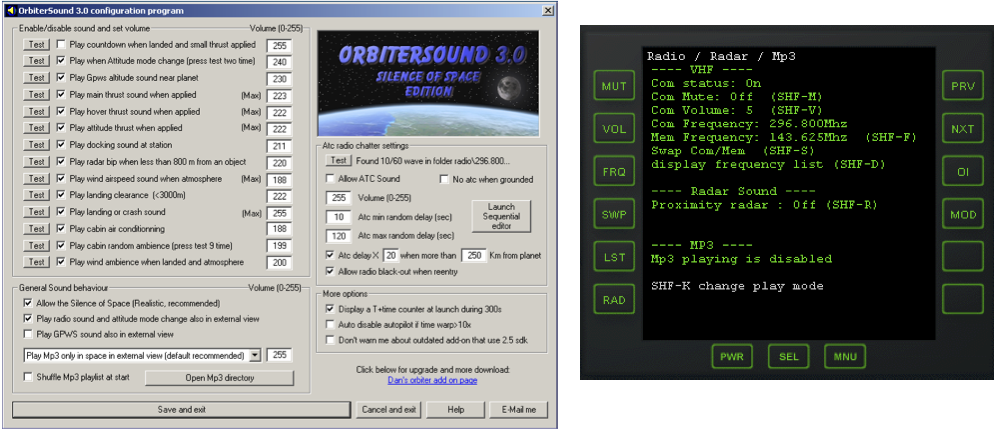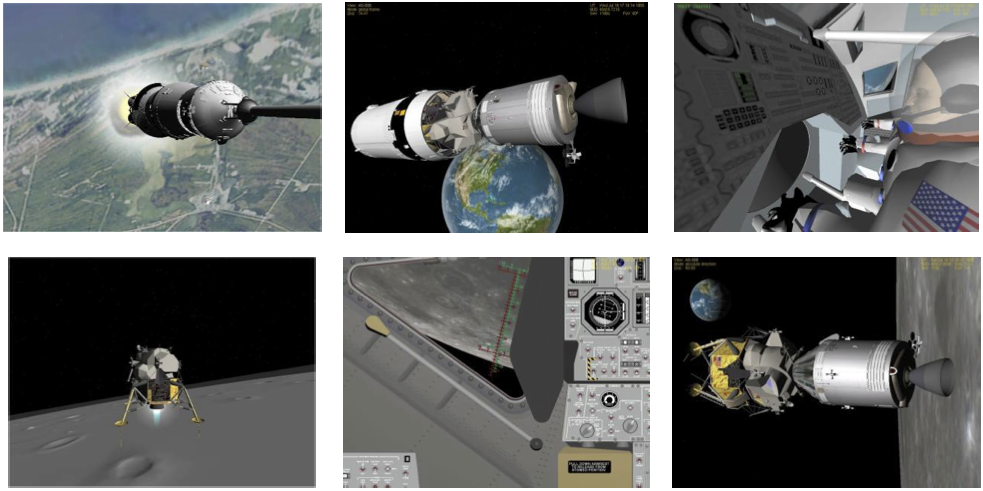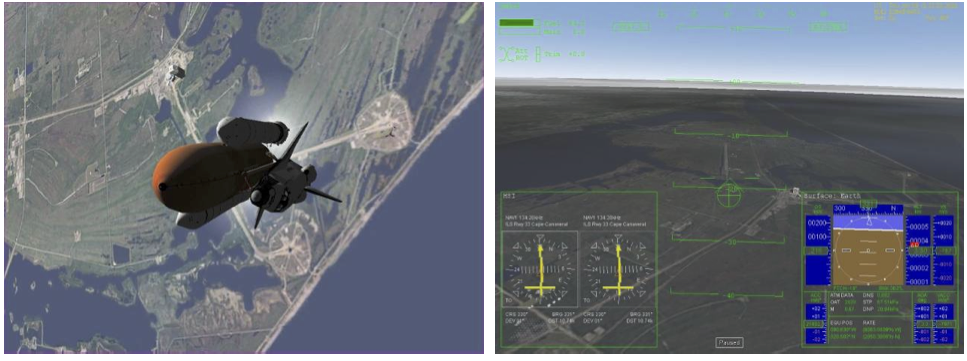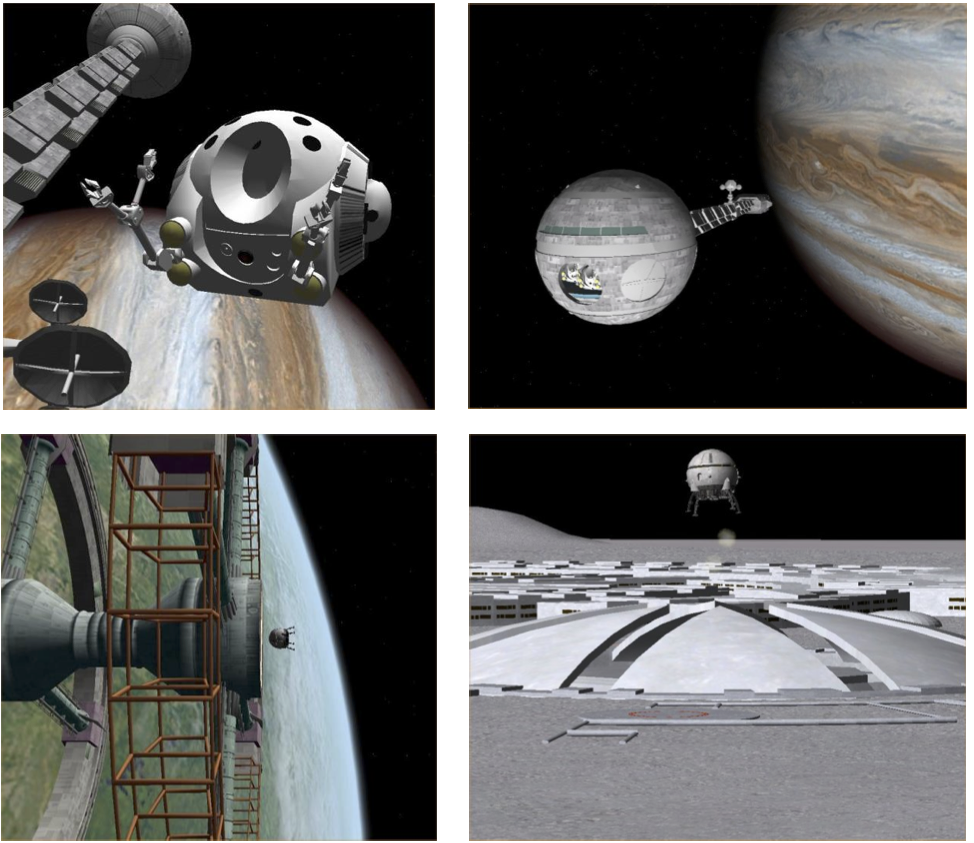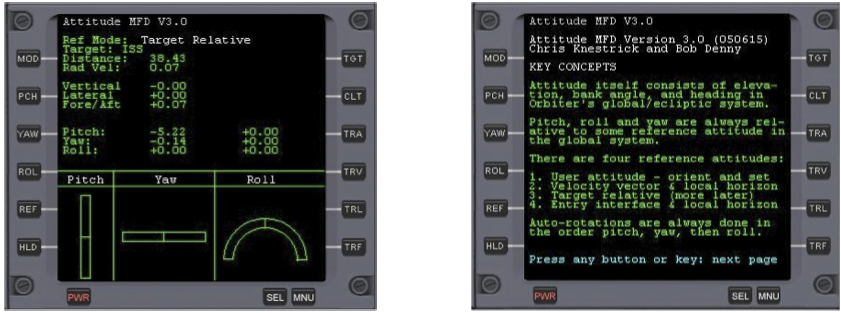Difference between revisions of "GPIS 9: A Bit About Add-ons"
m |
(set up for random page) |
||
| Line 252: | Line 252: | ||
Note: If LandMFD is installed, it may cause a problem with some scenarios. It seems to happen if you are using time acceleration when you cross the sphere of influence (SOI) of a planet or moon and if LandMFD is activated in the Launchpad, even if you are not using its MFD in the current scenario. Inside or outside the SOI, it seems OK. We’re not sure this is it – it’s just something that showed up in testing chapter 4 (Earth-Moon flight). If it happens, try de-activating LandMFD, fly until you get close to the target planet, quick-save the scenario, quit, activate LandMFD, and load and complete the saved scenario. LandMFD otherwise works well with Orbiter 2006. | Note: If LandMFD is installed, it may cause a problem with some scenarios. It seems to happen if you are using time acceleration when you cross the sphere of influence (SOI) of a planet or moon and if LandMFD is activated in the Launchpad, even if you are not using its MFD in the current scenario. Inside or outside the SOI, it seems OK. We’re not sure this is it – it’s just something that showed up in testing chapter 4 (Earth-Moon flight). If it happens, try de-activating LandMFD, fly until you get close to the target planet, quick-save the scenario, quit, activate LandMFD, and load and complete the saved scenario. LandMFD otherwise works well with Orbiter 2006. | ||
| − | |||
| − | |||
| − | |||
| − | |||
| − | |||
| − | |||
| − | |||
| − | |||
| − | |||
| − | |||
| − | |||
| − | |||
| Line 271: | Line 259: | ||
|style="text-align:right" width="33%" |[[GPIS_10:_I_Was_Just_Wondering|Chapter 10: I Was Just Wondering]] | |style="text-align:right" width="33%" |[[GPIS_10:_I_Was_Just_Wondering|Chapter 10: I Was Just Wondering]] | ||
|} | |} | ||
| + | |||
| + | [[Category:Tutorials]] | ||
| + | {{HasPrecis}} | ||
Revision as of 23:32, 7 March 2015
| Chapter 8: Learning And Doing More | GPIS Contents | Chapter 10: I Was Just Wondering |
Acknowledgement
This material was originally contributed by Bruce Irving from the 2nd edition of Go Play In Space (where it was chapter 8). Refer to the page's View History tab to see subsequent changes.
A Bit About Add-ons
One of the clever things that Martin Schweiger has done in designing and implementing Orbiter is to provide a flexible interface so that programmers and 3D graphic designers can create new features for Orbiter without his help. These are commonly called add- ons, and there are hundreds if not thousands of them in existence. This is a real gold mine for Orbiter users with special space interests. Chances are good that if it has something to do with space flight, past, present, future, or fictional, someone has created an add-on for it. If not, create your own (see http://www.eharm.net/shop/freeware/orbiter/developer/developer.html).
So in addition to the basic and optional high resolution graphics file downloads needed to install and run Orbiter, there is also a downloadable “SDK” (software developer’s kit) with examples, utilities, documentation, etc. that programmers can use to implement new spacecraft, textures, MFDs, 3D objects, help files, etc. Note that this does not mean that Orbiter is “open source” – Dr. Schweiger provides a free license for anyone to use the Orbiter software, but he retains all intellectual property rights to it. The SDK only defines the interfaces that programmers can use so their code can be linked to and understood by Orbiter. But it is flexible enough to allow, for example, not only new rocket engines, but even totally new forms of propulsion.
So this chapter is just an introduction to a few add-ons I believe to be especially useful, amazing, or just cool. It’s not really a how-to, but it does include some tips.
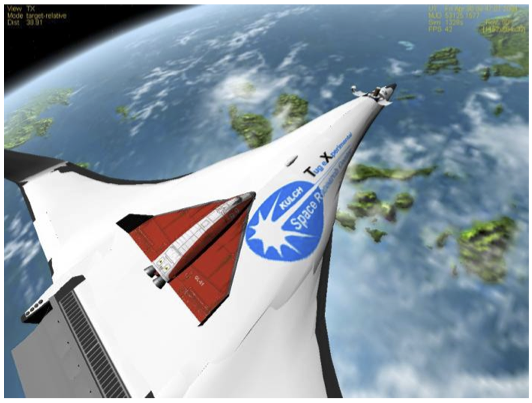
Add-on Mania
There is a certain danger in add-ons for Orbiter if you have any sort of inclination to collect things. There are just so many cool add-ons to find, download, and try (nowhere near Microsoft Flight Simulator, of course, but amazing nonetheless, and all free). So whatever your special interest in space, you can probably find add-ons related to it, though another slight danger is that add-ons are not always up to date and compatible with the latest Orbiter version. This is no one’s fault and no one’s responsibility – like Orbiter itself, add-ons are free, developed by Orbiter fans with programming and graphics skills for their own enjoyment, and shared for the benefit of other fans. But it’s not always as much fun to update something you developed two years ago – you may be busy with other things, or you may want to develop something new. But many older add-ons continue to work with the latest Orbiter, so you can at least try them if you are interested.
This chapter has profiles of some Orbiter add-ons I’ve chosen to feature because I think they are good – not necessarily the “top 10” add-ons or anything (though some certainly are) – I’m sure there are others I’ve never even tried that are fantastic. These are only my opinions of course. It’s a starting point.
Some of these profiles are more in-depth than others, and may even seem to be in the nature of a review, with notes on “cool things” and “cautions.” Add-on developers put a lot of time and work into these free “products” and I hate to criticize anything, since they don’t have to share their work in the first place (and no one forces anyone to use it). “Cautions” are mentioned mainly for the benefit of new users who may appreciate knowing that some add-ons don’t have extensive documentation and may assume more Orbiter experience and space knowledge than a typical new user may have.
Where and How to Get Add-Ons?
I’ve tried to give search and usage tips for most of the individual add-ons mentioned below, but here’s some general advice on finding and using add-ons:
- The main sites for add-ons are www.orbithangar.com (smaller add-ons, good search features, pages for latest and most popular downloads), www.spacesimmods.com (larger add-on files, good search features), and www.avsim.com (although this is mostly for flight simulators, it has a special Orbiter area in the File Library, and good search features). There are also files available on www.sourceforge.net, especially NASSP/Apollo (http://sourceforge.net/projects/nassp).
- Some authors choose to host their add-ons at their own web sites, or at friends’ web sites, or at other web sites of one sort or another. Check the “related sites” page of the main Orbiter web site for other possible download sites.
- Web sites and files can change, move, or even go away completely. Use Google.com to do general searches with as much information as you have about the add-on you are seeking. Any file names and versions mentioned are correct to the best of my knowledge as of the date of this writing (April 2006), but these things may change also.
- Visit the Orbiter Web Forum, especially the Addons Forum (Web Forum is linked from www.orbitersim.com). There you can see posts about new add-ons and discussions about add-on issues, and you can request information about an add-on you can’t locate. You will also find several “sticky” posts at the top of the main and Addon Forums with frequently asked information (where to download files, tutorial locations, tips for add-on developers, etc.). This information should be up to date, but if you find something that’s not, please post a comment on the forum. Someone else may know what the problem is.
- Most add-ons are supplied in zip files, and since most of them will include multiple files that must go into the right Orbiter folders to work right, most add-on makers follow the Orbiter convention of organizing the files into folders with the same names as the Orbiter installation folders (e.g., /config, /modules, /scenarios, /texture, etc.). If this is the case, you will see the folders (or the folder names in WinZip) when you open the zip file. You just need to unzip into Orbiter installation folder in a way that preserves the folder structure (e.g., check the “use folder names” button in the case of WinZip).
- A few add-ons will not have folders in the zip file and will require you to put the add-on files in the correct Orbiter folders yourself. Be sure to read the readme file or other documentation to make sure you know what to do in this case.
- Before you install an add-on, always check for a readme.txt or similar file and review it before installing. Make sure the add-on is compatible with your version of Orbiter, or be prepared to do a “clean” test installation with it to see if it will install and work.
- Keep in mind that while some add-ons replace existing files with an improved version, most will add files to the Orbiter installation. Some of these files can be large, and the main effect of this is typically to increase the load time when you start Orbiter. This is one reason it can be better to have several Orbiter installation folders where you install different types of add-ons, rather than install everything on top of one big Orbiter folder.
- There is at least one program which can be used to manage your add-ons. It is called Add-on Installer V1.1 by Thomas Kisiel. It is available on www.avsim.com (you can search for the file orbiteraddoninstallerv110.zip) and it can be quite useful. It allows you to keep track of which add-ons are installed, and even to selectively remove them. But to allow this, it keeps backup copies of all the old files, which can greatly increase the size of your Orbiter installation folder. It has a few limitations, but you may want to give it a try if you start using a lot of Orbiter add-ons (I have only tested this program with Orbiter 2005).
Have fun collecting and playing with the many add-ons for Orbiter!
| Multiple Orbiter Installations
You can have multiple installations of Orbiter on one PC. It’s just another folder and 80-300+ MB of disk space. This is especially useful if you want to try out an add-on that has not been updated for the latest Orbiter. You can make a clean installation of Orbiter, install the add-on, and try it out. If it works, great. If it doesn’t, you know it’s not compatible without having to consider whether the problem might be due to a conflict with another add-on (which sometimes happens). If you have lots of disk space, keep a basic installation of Orbiter installed with no add-ons (or maybe just Orbiter Sound), and copy this folder to a new folder when you need a “fresh” copy to try out an add-on. If you are short of disk space, burn this “master” install file to a CD to copy when you need to. |
Orbiter Sound 3.0
As discussed in Chapter 1, Orbiter Sound 3.0 is the closest thing to a “required” add-on for Orbiter (it was developed for Orbiter 2005 but works well with the 2006 version). It is available from its author’s web site, http://orbiter.dansteph.com. Dan has created a wonderful enhancement to Orbiter. It just adds so much to the experience and can’t really be compared with other add-ons. So I hope you are already “sold” and I will talk a bit about configuring Orbiter Sound.
Orbiter Sound installs its own configuration utility which is very useful (below left). Here you can choose the types of sounds you want to hear and set the audio volume and test each type of sound.
I personally like hearing almost all the sounds, but I like to turn down the relative volume of some of the background noises so I can hear the MP3’s better. I also tend to turn off “ATC” (air traffic control radio messages) since these are really only playing recordings from historical space missions (including Apollo 11) on a random basis (not connected with what you are doing). They are fun to hear a few times (and there are other “sound packs” available which I have never tried).
Note that you have a folder under the main /sound folder where MP3’s can be copied to hear in Orbiter. A better option is to use the WinAmp playlist file found in that same folder to define the songs you want to hear regardless of where the MP3 files are on your PC. WinAmp is a widely used media player with a lot of powerful features (free version available, see http://www.winamp.com ). The WinAmp playlist is actually a text file, so it’s possible to modify it with a text editor to add song files to it without even using WinAmp as long as you follow the format (I think Dan chose to use this as a convenient, text-based way to define a playlist – Orbiter Sound does not use WinAmp itself to play music, it makes use of media service routines that are available to applications running under Windows).
When you are in Orbiter, you can also change some settings of Orbiter Sound from its MFD (click [SEL] then [Radio/MP3 panel] – above right). Here you can control some individual sounds (e.g., you can disable the landing or docking proximity beep, which can get a bit annoying at times). You can also control when MP3’s are played (internal vs. external views) and you can skip tracks. Notice the CD- player-like sound control buttons (PRV, NXT, MUT, etc.) around the MFD in the screen shot above.
The Big Iron (Apollo, Shuttle Fleet)
These add-ons are projects that involve more than a single spacecraft, scenery addition, MFD, or special scenario. They involve all of these things and more and generally represent the work of teams made up of programmers, graphic artists, and others with a keen (some might say obsessive!) interest in a particular space program. Orbiter users get to share the fruits of their obsession and attention to detail.
NASSP 6.4.2 (Apollo)
This is a truly amazing add-on. NASSP stands for “NASA’s Apollo Space Simulation Project” and this project has been under way for several years. The current version allows you to simulate every important aspect of the Apollo Moon missions of 1968-1972, from the Saturn V launch to the astronauts walking on the Moon. It includes vehicles (Saturn V, Command/Service Module [CSM], and Lunar Module [LM]), panels, sounds, lunar bases (with 3D craters and hills), and scenarios. The Apollo 11 screen captures below are in intended to show the range of things you can experience with this add-on, but they are too small to show the incredible detail (clockwise from top left: Saturn V launch, docked with LM near Earth, CSM virtual cockpit view, lunar orbit, panel view from LM Commander’s window, close to touchdown at Tranquility Base).
Primary Author(s): The NASSP Team (administrator Markus Joachim, “tschachim”)
Where to Find It: The main link is http://sourceforge.net/projects/nassp/ which includes a link to the actual download page (download full 6.4.0 zip file plus patch files for 6.4.1 and 6.4.2, and install them in this order into an Orbiter folder, preferably one with Orbiter Sound and the Land MFD as the only other add-ons).
Check the main page for possible references to further patches and upgrades.
Cool Things: Too many to mention. It really has it all from super detailed spacecraft models to real radio recordings keyed to some mission events to clickable panels for both the CSM and LM to 3D bases to simulate the terrain found at the actual landing sites for each Apollo mission.
Cautions: The main one is complexity. Although there is a launch sequencer/autopilot that is easy to use to start the launch, other tasks are done with a simulation of the AGC (Apollo Guidance Computer), entering strings of numbers like the real astronauts did. Cool, but complicated. Of course you can still use the regular Orbiter MFDs (e.g., Transfer MFD), and you can use the Land MFD autopilot (available but not included in NASSP) to land the LM on the Moon. Another caution is that I have not personally tried out NASSP 6.4.2 with Orbiter 2006 as I had done for Orbiter 2005, but I have been assured by other Orbiter beta testers that it works OK.
Things to Try: Although conducting a full Moon mission with all the steps is a real challenge, there are easy things to try from supplied scenarios. There are mission scenarios for all the Apollo missions in the “Project Apollo – NASSP” folder, but the “Apollo 11” subfolder has scenarios for many steps of the mission. Launch of the Saturn V is automated as in real life (go to the internal panel view and watch the mission clock – just accelerate time 10x or 100x until about T-20 seconds, then go to 1x, listen to the countdown, and watch from various viewpoints). If you have the Land MFD, it’s fun to experience the Apollo 11 LM automatically landing at Tranquility Base (it seems best to start with one of the Apollo scenarios that come with the Land MFD itself).
Tutorials: There are several quite detailed tutorials around written for earlier NASSP versions. I have “spot checked” a few parts of these, and they seem to still work with the 6.4.2 version, but there may be some small differences. In any case, they are still quite helpful and will teach you a lot about how Apollo missions were done. As a tiny example, to extend the LM landing legs, you click the LDG GEAR DEPLOY FREE/SAFE switch on the “Explosive Devices” panel of the LM – the G key won’t work! How would you know this? Read all the (PDF) manuals! The switch location would be in the “NCPP LM Instrument Panel Manual.pdf” and the procedure is in “NCPP LM checklist.pdf”. Also check the Orbiter Web Forum “sticky” post on tutorials for additional information.
Note For Older Tutorials: Before Orbiter 2005, PeR (periapsis radius) was called PeD (periapsis distance, I guess). Similarly ApD is now ApR. This was changed when the altitude feature (DST button) was added, probably to avoid confusion on “distance from what?” (PeA is altitude from surface, PeR is radius from planet center). Older tutorials often refer to PeD and ApD – just think PeR and ApR instead.
- Apollo Lunar Mission Tutorial by John Dunn (http://www.jdkbph.com/ALMT/index.htm) - Written for NASSP v4, it is very detailed, with background info and screen shots as well as procedures. Uses the standard Transfer MFD (as in chapter 4 here) for the first part of the mission (to the Moon) and the TransX MFD for the Moon-Earth phase. PDF files available for download on each page.
- Orbiter Apollo 11 Tutorial (by “SaturnV” – search www.orbithangar.com for tutorial, filename OrbiterApollo11Tutorial.pdf) - Written for NASSP v5, also is very detailed, well illustrated, and informative. Uses the TransX MFD which has not been covered in this book.
- How to get to lunar orbit the easy way tutorial (by “Bob7” – search www.orbithangar.com for tutorial, file name to_the_moon_the_easy_way2.pdf) - For NASSP 5.2, shorter and simpler than the other two, but only goes as far as LOI (lunar orbit insertion, not the landing and return to Earth).
Space Shuttle Fleet (current version as of April 2006 is 3.8.5)
Although Orbiter includes a version of the Space Shuttle Atlantis which is quite good, the “Shuttle Fleet” add-on series is much more complete and detailed in many ways, including an excellent launch autopilot (the default Atlantis must be hand- flown to orbit, which is actually not that realistic). It’s called the “fleet” because it includes separate downloads for Atlantis, Challenger, Columbia, Discovery, and Endeavor (Challenger and Columbia were of course lost in real life, but since many Shuttle fans like to re-create historic missions and payloads, they are still included in the Orbiter fleet). Each download includes payload objects, configuration files, graphical textures, authentic sounds, and scenarios appropriate to the Shuttle in question. This means that during an Endeavor mission, you will hear authentic radio calls for mission events such as, “Endeavor, Houston, negative return,” (meaning that the Shuttle has reached the altitude and distance from launch that is beyond the range for returning to Kennedy Space Center in the event of a serious problem, so it would have to land in Europe or North Africa or “abort to orbit” for any problem after this point). Screen shots: looking back at Kennedy Space Center (KSC) shortly after launching Endeavor (left), and a no-panel view on final approach for runway 33 at KSC, with the HSI MFD for instrument landing guidance, and the Surface MFD for general flight information (MFDs are transparent in this view, which is an option you can set in the Launchpad).
Primary Authors: Don Gallagher, Dave Hopkins
Where to find it: Try www.orbithangar.com and search (by author) for david413 or (by name) Shuttle (this will find other types of “shuttles” as well) to find the five current Shuttle Fleet downloads (6-8 MB each) and any special add-ons (e.g., additional payload files). There have occasionally been some hosting problems, so check the Orbiter forum if you have trouble finding the Shuttle Fleet.
Cool Things: Authentic and detailed in so many ways. Excellent graphical modeling including virtual cockpits (unfortunately non-clickable); autopilot for realistic launch sequencing (be sure to activate the GPC MFD from the Launchpad since this is the launch autopilot); working “robot arm” for manipulating payloads. Atmospheric flight modeling (for landings) seems to be good. Excellent integration of sounds captured from actual missions. Up to date (e.g., payload and other information were available for the July 2005 STS-114 flight of Discovery at the time it actually took place).
Cautions: The major one is that there is no mouse-enabled panel, so you need to use key commands for most things (you can use the no-panel MFD and autopilot buttons). The documentation is also somewhat limited. A PDF with all key commands and some other information is included, but not much else. Some of the Shuttle information in the Orbiter main manual (orbiter.pdf) and in the two Atlantis PDF files supplied in the Orbiter /Doc folder can be useful with the Shuttle Fleet, though key commands can be different. You can find tips in the Orbiter Forum on flying the Shuttle Fleet, but you will find it easier to first get familiar with Orbiter using the Delta Glider (etc.) before trying a lot of things with the Shuttle. A realistic fact of life for the actual and simulated Shuttles is that the fuel load is very limited – unlike the DG, you typically can’t make big orbit changes with the Shuttle (even getting to orbit can be tricky without the launch autopilot – almost no fuel margin for mistakes). You can’t even make up for this by using Orbiter’s “unlimited fuel” option, because the Shuttle must lose a lot of mass by burning fuel during its ascent, or its engines won’t have enough thrust to raise it to orbit!
Things to try: Any of the launch missions is easy to do with the launch autopilot and fun to watch and listen to (but see tip below). It is also fun and easy to play with trying to land the Shuttle from a final approach scenario (watch the tutorial playback first), though doing a full re-entry to landing is quite a bit harder. It’s not included with the Shuttle Fleet, but there is a reentry autopilot add-on for Shuttle reentry. It is called AutoFCS (file is http://www.rmnorman.com/Orbiter/AFCS2p1.zip by author Mike Norman, “Mikey451” on the Orbiter forums). This can control the reentry from the de-orbit burn (typically over Western Australia for KSC landing) all the way to stopping on the runway. Pretty amazing.
| Easy But Semi-Cryptic Launch Codes
The special autopilot for the Shuttle Fleet is called GPCMFD 3.0 and it is installed with the Shuttle Fleet files. First activate it in the Modules tab of Launchpad. Run a Shuttle launch scenario and open GPCMFD with [SEL] and [GPC MFD]. You will see MFD buttons [OPS] and [ITEM]. Click [OPS] and enter 1 for mode 1 (Ascent). Then click [ITEM] and enter the special item 777 followed by the Enter key. This will start the launch countdown at T-10 (10 seconds to launch). See the supplied manual (GPCMFD V3 Manual.pdf) for more details. It’s automatic up to MECO except you will need to make a small OMS engine burn near apoapsis to raise the periapsis and circularize the orbit. |
Tutorials: I haven’t found any full tutorials specifically for this latest release of the Shuttle Fleet, but several pages at Eugene Harm’s site are very helpful.
Installation tips and zip file with some scenarios and a PDF “Shuttle Launch Guide” – This really is a sort of mini-tutorial since it includes both the real Shuttle timeline events and the few Orbiter procedures that are needed (it assumes the add-ons he recommends are installed): http://www.eharm.net/shop/freeware/orbiter/addons/atlantismod/atlantismod.html
A very informative review and discussion of the previous 3.8.2 Shuttle Fleet: http://www.eharm.net/shop/freeware/orbiter/addons/endeavour/endeavour.html
A description of how to de-orbit and land the Space Shuttle (by Kevin Stoffel): http://www.eharm.net/shop/freeware/orbiter/tutorials/orbiter_instrument/deorbit.html
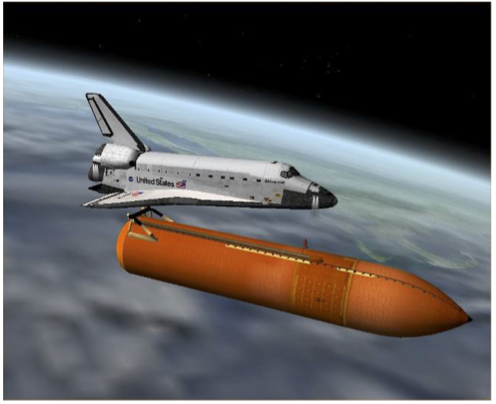
Toward a Better Looking Universe
Orbiter comes with some nice looking planet textures in the default installation, and there are standard high-resolution textures available for download and installation, now up to level 10 for Earth and Mars, with lower resolution levels for other planets and moons. Orbiter also allows add-on developers to define new surface and cloud textures for existing planets, and many have used data from NASA and other sources to create alternate surface textures for the Earth, Mars, and other Solar System planets (such as the futuristic terra-formed Green Mars*, above left, with Kulch’s space elevator* - see footnote on next page for file information). Orbiter add-on developers can also add additional planets such as Pluto* (above center with New Horizons* spacecraft add-on), various asteroids, and many smaller moons of the Outer Planetswhicharenotincludedbydefault. Orbiteradd-ondevelopers(orevenuserswhochoosetoedit various “config” files – OK if you really know what you are doing) can even modify the properties or the Sun or the planets. This can be useful if you want to define scenarios that take place in much earlier or far future times (the orbital elements of the planets change slightly over time).
You can even completely redefine the Solar System to represent a hypothetical one for a different star (and define a whole new set of hypothetical planets to go with it). Developers can also define special highly-detailed textures for small areas (such as the default detailed area around Kennedy Space Center), as well as additional surface bases that can include 3D features (buildings, launch pads, craters, hills, lunar cities, etc., such as the detailed Vallis Dao* region of Mars, above right, with Mars Direct* development vehicles). You could call all of this stuff “scenery” and there is quite a lot of it on the web.
Changes in 2006
Scenery (especially textures) is relatively “static” and may not be quite as version dependent as some other sorts of add-ons (such as spacecraft) that interact more extensively with the Orbiter “engine,” although there is an important exception to this statement in the 2006 version of Orbiter. In order to support higher level textures more efficiently, Dr. Schweiger changed the structure of some of the planetary the texture files. This affects mainly planets with reflecting (water) areas and night lights (mainly Earth) for resolution levels 9 and above (9 was the highest resolution in Orbiter 2005, while Orbiter 2006 supports level 10). Planets without reflecting areas and night lights and with resolution levels of 8 and below are not affected. Cloud maps are also not affected.
This means that alternate high-resolution textures of Earth will need to be re-done, but the good news is that that new L10 Earth texture available for optional installation with Orbiter is quite good, as is the new L10 Mars texture (although that one is huge, 175 megabytes compressed as a zip file, much more when installed – this needs a good graphics card to run well). The other good news is that since most other planets and moons do not have water and lights, most existing texture add-ons for other planets (which tend to be level 8 at most due to limited available data from space probes) should work fine. Orbiter does not include Pluto by default, so a nice addition is Pluto/Charon 2.0* by NightHawke. It is visually quite cool, although the surface details are necessarily conjectural since the first spacecraft that will visit Pluto (NASA’s New Horizons*) launched in January 2006 and will not reach its target until 2015.
It is better to use add-ons that are intended for Orbiter 2006 when possible (with 2005 as a second choice that will often work). Some really old add-ons may not work at all, although they sometimes can be made to work with some fairly small but technical changes (e.g., editing something in a configuration or scenario file may be easy to do, but only if you know what you’re doing).
Finding New Scenery
The site www.orbithangar.com hosts many smaller scenery files (bases, planets, asteroids, launch pads – 189 files in a recent search). The companion site www.spacesimmods.com hosts many of the larger files, especially high-res planet and moon textures (do a search for Category Scenery, Sub-category Textures to find them). Although it doesn’t have specific scenery categories, you can also try searching the Orbiter area of the AVSIM File Library for the words textures or planet (these produce quite a few hits – see www.avsim.com – registration may be required to download).
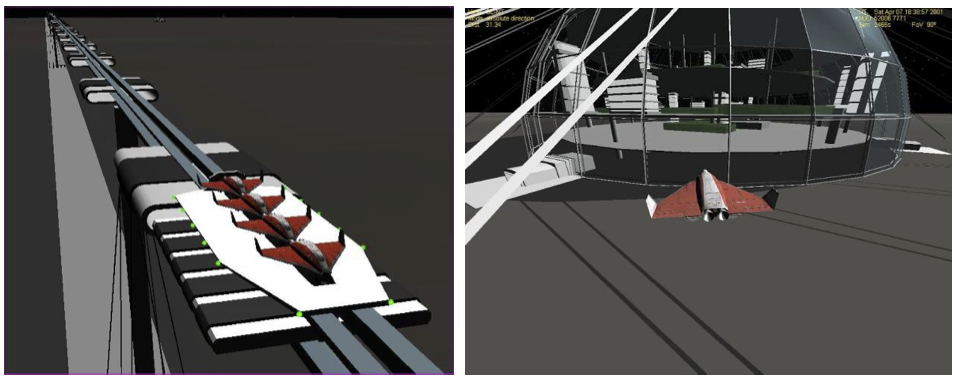
* Orbit Hangar (www.orbithangar.com) files for other add-ons mentioned above:
Vallis Dao Mars terrain by jtiberius (VallisDao.zip); Space Elevator by Kulch (SpaceElevator4.zip); Pluto/Charon 2.0 by NightHawke (Pluto-Charon_v2.0.zip); New Horizons by castorp (New Horizons.zip); Mars Direct 2004 version by jgrillo (Mars Direct Project.zip – HAB and Rovers shown are in development for a new Mars Direct add-on and are not yet generally available); Green Mars by Schimz is available only at www.avsim.com (greenmars.zip)
Spacecraft and Space Stations Galore
Add-on developers seem to really like making spacecraft, and they have been greatly helped by “Vinka” (http://users.swing.be/vinka/) who developed the “old” (but still used with many add-ons) spacecraft.dll and multistage.dll plug-in modules (and newer spacecraft2.dll and spacecraft3.dll) which allow physical, performance, and even animation properties to be defined in text files rather than by custom programming. This makes it easier for people whose skills and interests are mostly in the development of 3D models to turn these into operating spacecraft. Note that simple spacecraft can be defined in Orbiter without customized DLL’s or even Vinka’s DLL’s. Such “config file” spacecraft require only a 3D model and a .cfg text file to define its properties.
Historical Spacecraft
This is a category that includes both piloted and unpiloted spacecraft. In the piloted category you can find Project Mercury, Gemini, Apollo (see NASSP above), Soyuz, Space Shuttle, X-15, and SpaceShipOne, as well as some that were designed but never built, such as the U.S. Air Force DynaSoar “space plane” from the sixties. Unpiloted craft start with the pioneers – Sputnik, Explorer 1, Vanguard, and include many lunar and planetary probes (Ranger, Surveyor, the Pioneers, the Mariners, Viking, Voyager, Galileo, many more). There are also launch vehicles from various periods from the US, USSR/Russia, Europe, and a few others (e.g., WWII era German V2). There is even an add-on featuring the small test rockets flown by Robert Goddard in the 1920’s and 1930’s (this Early Rockets add-on was developed by Mark Paton, who has done a number of excellent add-ons for Orbiter, search for Paton at www.orbithangar.com). Most of the spacecraft mentioned above are also at Orbit Hangar.
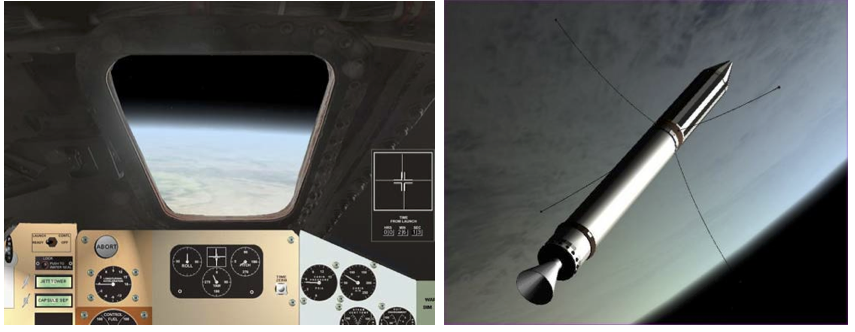
Future Spacecraft
This category includes spacecraft and space stations that attempt to realistically portray some future propulsion system or other technology – a spacecraft that could possibly be designed and built someday, at least within the laws of physics, even if the technology does not yet exist. You could still call these ships “fictional” since neither the ship nor in most cases the needed technologies actually exist. These include ships with nuclear rocket engines (fission or fusion), ion engines, solar sails, mass drivers, space planes, space elevator cables (perhaps more likely at first on the low-G Moon), various space colony concepts, and even “star ships” based on some of these technologies and perhaps capable of a few percent of the speed of light. Some of these ideas are pretty “far out,” but this still differs from various clearly fictional ships that use “warp drives” or other methods to equal or exceed the speed of light. Under the physics that we know today, it is not possible for an object of non-zero mass to travel at light speed, let alone exceed it. New laws and “loopholes” (or maybe “wormholes”) may someday be discovered to change this. Until then, warp drives and such can be considered fiction.
ESAS CEV – ESAS is NASA’s “Exploration Systems Architecture Study,” which defines its future plans for the Moon and eventually Mars (part of the Vision for Space Exploration, VSE). CEV is “Crew Exploration Vehicle,” and the late 2005 ESAS study pinned down the basic architecture and design of these post-2010 spacecraft to be at least superficially similar to the Apollo command and lunar modules (but quite a bit larger). The ESAS CEV add-on by “Francisdrake” is a very nice implementation of the design as currently envisioned by NASA (the detailed design will be determined by the winning contractor team). The author recommends another add-on by Simcosmos (António Maia) that implements several variations on the proposed CLV (Crew Launch Vehicle, above left). Both are available at Orbit Hangar. The ESAS final report is available from www.nasa.gov (search for ESAS).
ESAS CEV: http://www.orbithangar.com/advsearch.php?search=name&text=ESAS
VSE CLV: http://www.orbithangar.com/advsearch.php?search=name&text=vse
The Rocket Company DH-1 – This add-on is based on the book The Rocket Company by Patrick J. G. Stiennon, David M. Hoerr, and Doug Birkholz (search at www.amazon.com). Although it is fiction, it is actually a technically detailed case study of the formation of a private space company that develops a unique, fully-reusable two-stage launch vehicle. The piloted first stage launches straight up so it can return to its pad with jet hover engines while the piloted second continues to orbit. It’s a very cool concept, and I enlisted the help of Andy McSorley and later Mark Paton to develop an Orbiter add-on for the DH-1 so we could try out the concept (it works!). Download and read the included PDF to learn more.
DH-1 “Final” Version (zip file): http://www.orbithangar.com/download.php?ID=2193
Others – Other Orbiter add-ons in this category include our familiar Delta Glider, Dan’s greatly enhanced Delta Glider III (http://orbiter.dansteph.com); Kulch’s TX4 winged launcher (shown at the start of this chapter, www.orbithangar.com, search for author mulch); and Ken Bolli’s excellent TTM24 (To the Moon in 24 Hours, www.orbithangar.com, author boll, and try the tutorials on TTM24 at the Virtual Spaceflight web site, http://www.aovi93.dsl.pipex.com/ttm24_tutorials_index.htm ). Greg Burch has created a beautiful series of late-21st century ships, stations, and bases that are simply amazing, (http://www.orbithangar.com/searchauth.php?search=gregburch). These are must-have add-ons.
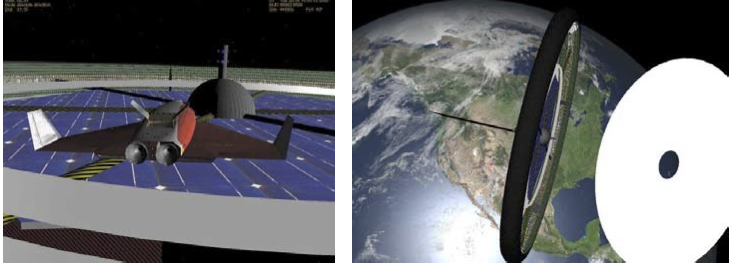
Fictional Spacecraft
A huge category that includes Star Wars (below right), Star Trek, and many others fictional worlds. There is certainly lot of material for inspiration, from golden oldies (Space 1999) to recent shows and films (Firefly space freighter from the TV show and the movie Serenity, below center).
It also includes what you might call “retro-future” systems such as the spacecraft that were illustrated in articles by Werner von Braun in Colliers magazine in the early 1950s (picture above left shows the “Wheel” space station and the “Ferry Rocket” multi-stage rocket). “World of Colliers” 2.01 is an incredible multi- vessel add-on with spinning space stations, classic pointy-nosed big-finned rockets, and bug-like lunar landers by Erik Anderson a.k.a. Sputnik and John Graves a.k.a. Missleman01 (search for colliers at orbithangar.com). Many of the concepts of modern space flight were laid out in the pages and paintings of those articles – and even if the designs are not practical by modern standards, they still look pretty cool. They really managed to capture in 3D the look and feel of Chesley Bonestell’s classic paintings.
My personal favorites in the fictional spacecraft category are the various craft from 2001: A Space Odyssey and its sequel, 2010 (the Discovery is shown near Jupiter, above, top right). Rip a copy of Strauss’ Blue Danube Waltz (or the 2001 soundtrack) and listen while you recreate scenes from the movies.
World of 2001 – The team of Sputnik (yes, Erik Anderson again), 80mileshigh, and Nautilus created in 2005 what is perhaps the ultimate 2001 tribute with their massive 23 megabyte “World of 2001” multi- vessel, multi-base add-on. The 15 page PDF manual alone is 1.5 MB and describes the many ships (Orion, Titov, Aries, Moonbus, Polaris, and of course the massive rotating Space Station V, lower left above – some of the ships and bases are only mentioned in Clarke’s books or the movie, not actually shown, except here). There is a separate manual for the many bases, including a beautifully done Clavius Moon base (lower right, above), complete with an animated retractable dome, as well as the Tycho excavation site with the mysterious TMA object. This add-on is a literally a work of art!
Download: http://www.orbithangar.com/advsearch.php?search=name&text=world+of+2001
2001/2010 Vessels – As fantastic as Wo2001 is, it doesn’t let you ask HAL to open the pod bay doors.
For that, you need the file 2001_2010vessels.zip by David Bartles (dbartles2). This 2004 add-on seems to work fine with Orbiter 2006, and it fills out the world of 2001, extending it into 2010 (the movie), with the Discovery (upper right, above), the Leonov, and yes, the famous pod bay doors and pods (Work Pod Betty shown above, upper left, apparently operated remotely by HAL). The arms are even animated, with numeric control keys for all the joints (read the PDF). Amazing work!
Download: http://www.orbithangar.com/advsearch.php?search=name&text=2010
MFDs for All Reasons
Add-on developers have created MFDs for all sorts of applications from the simple (e.g., a count down timer) to the very complex. I will discuss three examples that I find especially useful.
Attitude MFD
Attitude MFD V3.0 (050618, seems OK with Orbiter 2006)
Download: Go to www.orbithangar.com and search for attitude (file AttitudeMFD050618.zip).
'Add-on Description: This is the MFD mentioned in chapter 3 that provides the translation equivalent of “kill rotation,” but it does a lot more than this. Robert Denny updated the Attitude MFD for Orbiter 2005, and his orbithangar.com description is pretty concise, so I will quote an excerpt here.
Updated version of Chris Knestrick's Attitude MFD. This is version 3.0. Attitude MFD provides the user with attitude information (pitch, yaw, and roll) with respect to a pre-selected reference attitude. It also provides an "Attitude Hold" mode to automatically hold the desired attitude. Finally, it provides the ability to "trim" velocity relative to a target to zero in each axis separately or in various combinations. It is really useful in the terminal phase of a rendezvous, where it can be used to orient toward a target and match its velocity precisely.
This really is a great add-on though some may feel that it makes docking a little “too easy.” I believe there is no such thing as too easy when it comes to tools (but there’s also something to be said for learning to do things manually and then to choosing to do them automatically – but it’s up to you). The screen shots below show the Target Relative mode (left) from a docking scenario with the ISS nearby as the target. You can see that the distance is 38.43 m and the Fore/Aft velocity is +0.07 m/s (to “kill” this velocity, assuming the Attitude MFD is on the left side, type Left q5 (keypad-5 - this is easy to remember since keypad 5 alone is “kill rotation” – clever idea). The right screen shows part of the built-in help added with version 3.0 (click the [MNU] button 3 times until you see the [HLP] button).
IMFD 4.2
Interplanetary MFD - Space Navigation Computer Version 4.2.1 (patch for 2006) Download: The author’s web site, http://koti.mbnet.fi/jarmonik/Orbiter.html (file imfd.zip)
Add-onDescription: Used in the Mars flight in chapter 6, this wonderful and still-improving add-on is extremely powerful and “deep” with many tools for all phases of navigation within the Solar System. Although it has many features and requires some study and practice with tutorials to master, its diagram- oriented interface is very well organized (within the constraints of the MFD screen/button interface). Its automated features can really help the beginner, including an auto-burn feature that will orient the spacecraft dynamically as it makes required burns for the various phases of a trip (orbit eject, course corrections, and even precision base approach that allows you to set up your arrival at a planet for convenient access to the desired surface base). The highly accurate Map program allows you to view the details of your trajectory at any desired point and scale. There’s more information on IMFD on page 6-4, along with a number of screen shots showing its actual use for an Earth-Mars flight.
Tutorials: I recommend that you be pretty comfortable with general spacecraft and MFD operations and have one or two Transfer MFD Moon trips done before you tackle IMFD. Chapter 6 is then a logical next step. Then you might try one of the detailed tutorials listed under “Interplanetary MFD - Flight School” on Jarmo’s web site (probably Habana to Brighton Beach for a look at a precision Moon flight, or Jarmo’s Earth-Mars tutorial). The guest tutorials by “FlyBoy” (slingshot) and Rob Denny are quite good (Rob’s IMFD tutorial is “Europa To Callisto” – the zip file has a detailed PDF and scenario files for all steps of the tutorial – Rob’s own web site is http://solo.dc3.com/orbiter/ ). IMFD is worth some effort to master – it will unlock the Solar System and teach you a lot about orbital mechanics.
LandMFD
Landing Autopilot for No-atmosphere De-orbit by Dennis Hare a.k.a. LazyD Download: At Andy’s site (http://www.aovi93.dsl.pipex.com/others_addons/LandMFD0514.zip)
Add-onDescription: This MFD is astounding to watch in action as it precisely de-orbits and lands the Apollo Lunar Module (if you have NASSP 6.4.2 installed, see above), up to 6 Shuttle-A cargo ships simultaneously approaching Brighton Beach from different orbits, or a number of other add-on ships I have yet to try (scenarios are provided for various add-ons, especially Apollo/NASSP, but you must install the corresponding add-ons first). All you really need is a hover-capable ship in an orbit that passes near the target base, and LandMFD can usually do the rest once you engage the autopilot.
Install and activate LandMFD in the Modules tab of Launchpad and read the readme.txt file for general instructions (important – while it needs few controls, it seems to have no MFD buttons, so you must know that shift-0 [zero] will engage or disengage the autopilot). Then run the one scenario in the LandMFD folder labeled “Orbiter” - “Brighton Beach Different Orbits” to see it control and land six ships at once (autopilot is engaged when scenario opens). You might then try it with the Mars landing in chapter 6 (see screen shot there – pre-landing scenarios are available so you don’t have to fly the whole thing to see the landing).
Note: If LandMFD is installed, it may cause a problem with some scenarios. It seems to happen if you are using time acceleration when you cross the sphere of influence (SOI) of a planet or moon and if LandMFD is activated in the Launchpad, even if you are not using its MFD in the current scenario. Inside or outside the SOI, it seems OK. We’re not sure this is it – it’s just something that showed up in testing chapter 4 (Earth-Moon flight). If it happens, try de-activating LandMFD, fly until you get close to the target planet, quick-save the scenario, quit, activate LandMFD, and load and complete the saved scenario. LandMFD otherwise works well with Orbiter 2006.
| Chapter 8: Learning And Doing More | GPIS Contents | Chapter 10: I Was Just Wondering |
Precis
This article has a precis and appears in the Random addon or Random article section on the Main Page. The precis can be found at GPIS 9: A Bit About Add-ons/precis and is displayed below.
|
Go Play In Space, Chapter 9. Go Play In Space is the classic introduction to Orbiter for new orbinauts and those looking to expand their horizons. Chapter 9 provides a guide to the main resources for add-ons to expand on Orbiter’s built-in capabilities, with additional tools and spacecraft. (More...)
|
